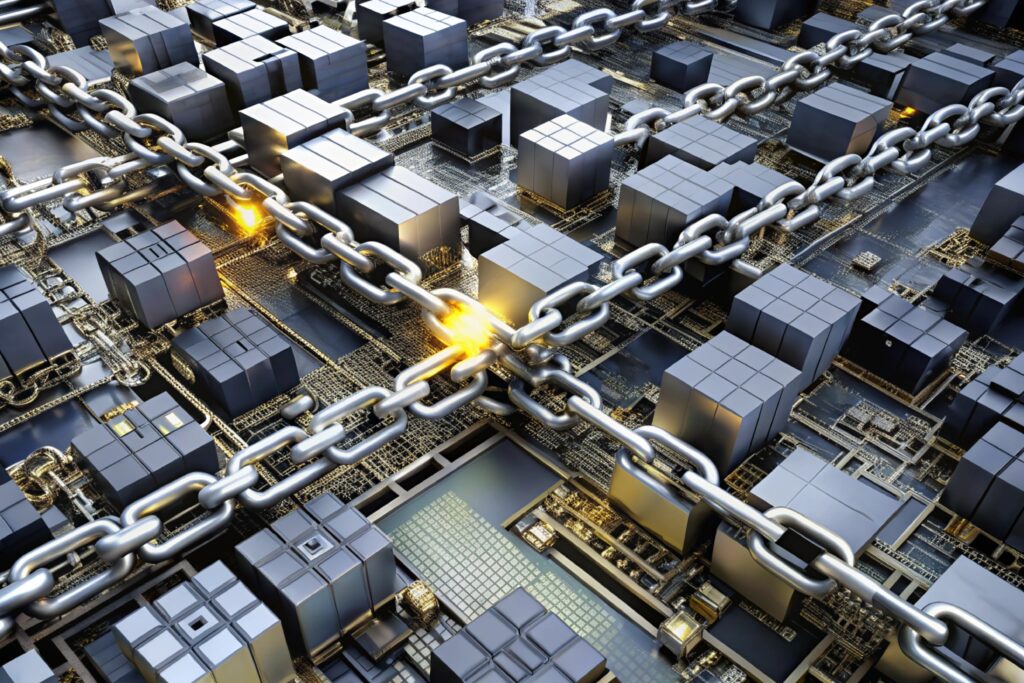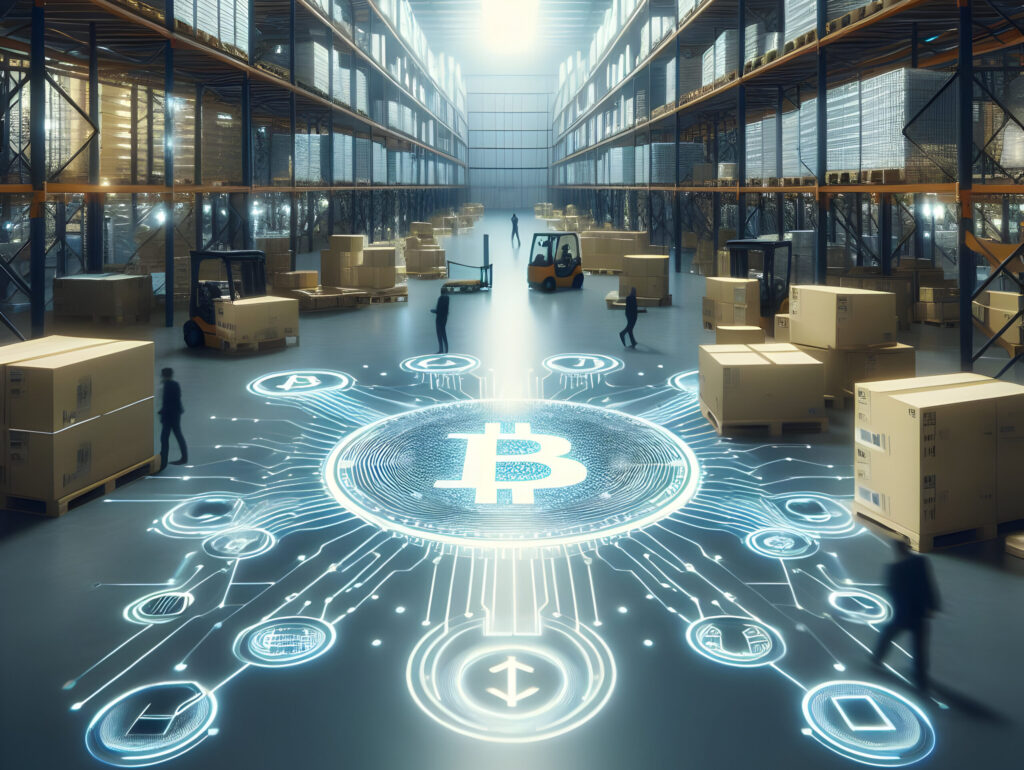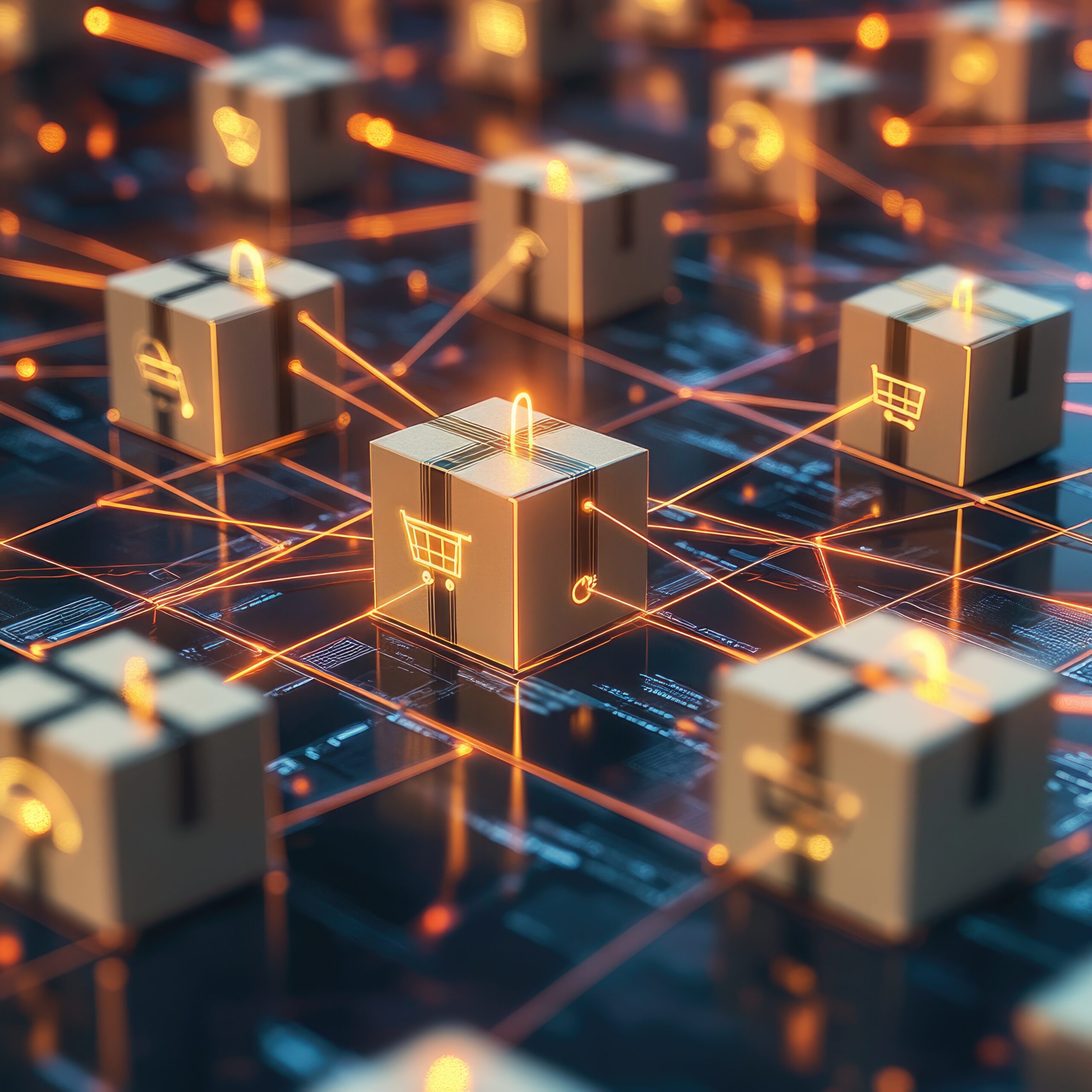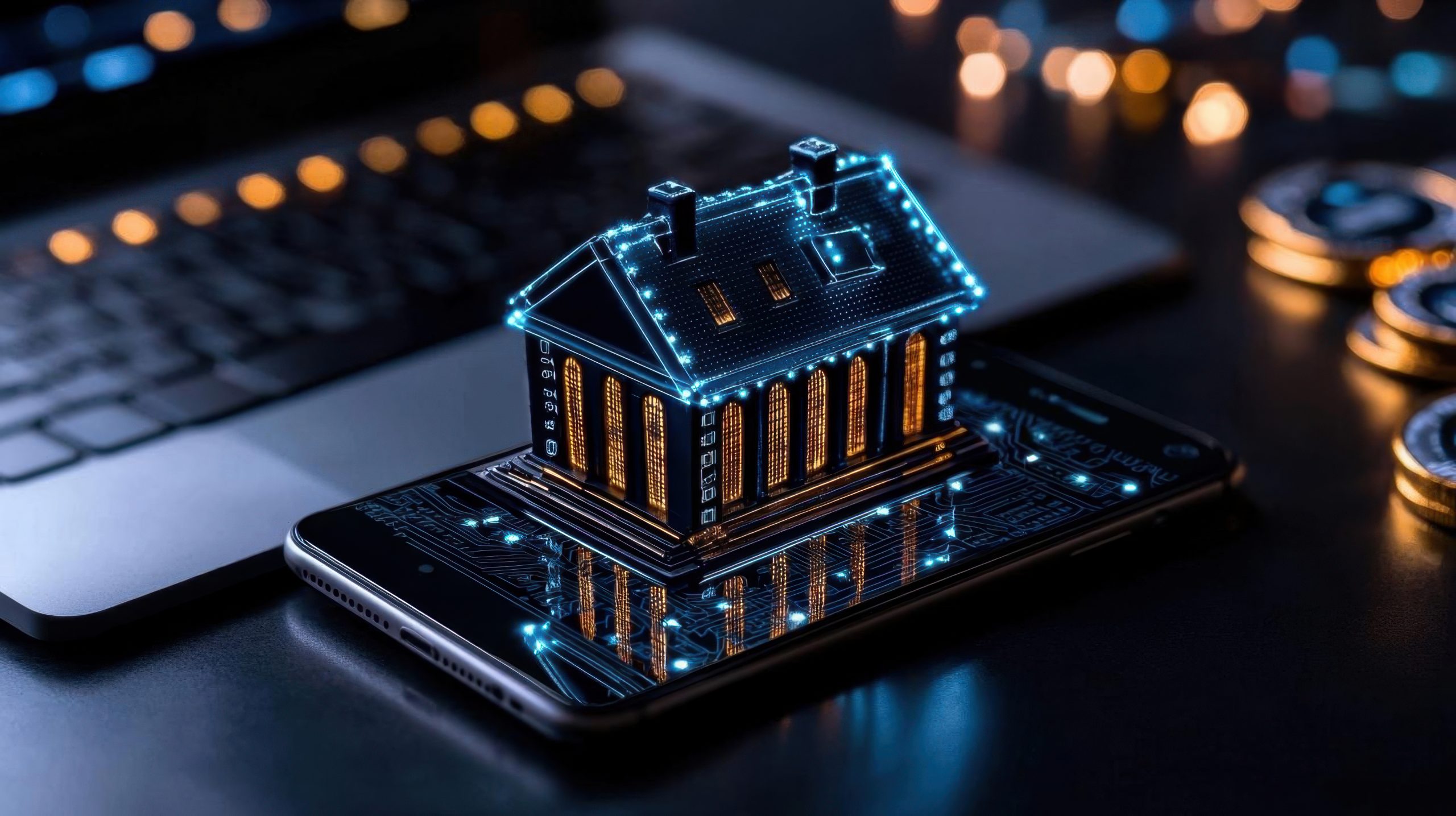Your product changes hands 15 times before reaching customers. Each transfer creates paperwork. Information gets lost. Companies can’t track where things really come from.
This creates expensive problems. Food poisoning outbreaks take weeks to trace back to the source. Counterfeit luxury goods flood markets. Customers demand sustainable sourcing but can’t verify claims. Supply chains break down because nobody has the full picture.
Blockchain technology in supply chain management solves these issues by creating permanent records that everyone can see. When Walmart needed to trace contaminated lettuce, it took six days using traditional methods. With blockchain supply chain tracking, the same process takes seconds.
Companies using blockchain for supply chain transparency can prove their products are authentic. They catch problems faster. Customers trust them more because the data can’t be faked. The technology works because it connects all parties with verified information they can actually rely on.
Current Supply Chain Landscape
Supply chains today are a mess. Most companies have no idea what happens beyond their direct suppliers. Only 2% can see into their third-tier suppliers, which means they’re flying blind when problems hit.
Last year was brutal. Three-quarters of European shippers dealt with supply chain disruptions. One in four companies faced over 20 separate incidents. The financial damage? Companies lost an average of 8% of their annual revenue to supply chain problems.
Here’s what’s actually happening on the ground. Your raw materials now take 81 days to arrive instead of the 65 days before COVID. That’s a 25% increase that ripples through everything. Warehouses sit half-empty while customers wait. Production lines stop because one small component is stuck somewhere.
Companies still track things with spreadsheets and paper forms. Different suppliers use different systems that don’t talk to each other. When something goes wrong, nobody knows where the problem started. Walmart discovered this the hard way – it took them six days to trace contaminated lettuce back to the source.
Meanwhile, new laws are making things worse. Germany’s Supply Chain Act forces companies to prove their suppliers aren’t using forced labor. The EU wants documentation showing products don’t contribute to deforestation. But current tracking systems can’t provide that proof.
Customers have gotten demanding too. They want to know where their products come from, how they’re made, and whether workers get fair wages. Companies make promises about sustainability but can’t back them up with real data.
Counterfeit products cost businesses billions every year. Luxury brands watch fake versions flood the market while struggling to prove which items are authentic. Even worse, fake medications and food products put people’s lives at risk.
How Can Blockchain Help?
Blockchain creates a permanent record that nobody can change. Every transaction gets recorded with a timestamp and linked to previous entries. Once information goes into the blockchain, it stays there forever. This solves the fundamental trust problem in supply chains.
Real-time tracking becomes possible across all participants. When a shipment moves, the blockchain updates automatically without human intervention. Everyone sees the same information at the same time. No more calling suppliers to ask where things are or wondering if documents are accurate.
Smart contracts automate verification and payments. These programs execute automatically when conditions are met – payments trigger when goods arrive, compliance gets verified when certifications upload. This eliminates delays and reduces disputes between parties.
Product authenticity becomes verifiable. Each item gets a digital identity that follows it from origin to customer. Luxury brands can prove their products are genuine. Food companies can trace contamination back to specific farms in minutes instead of weeks. The jewelry industry uses blockchain to verify that diamonds come from ethical sources.
Counterfeiting becomes much harder. Blockchain records make it possible to verify the entire journey of products from raw materials to finished goods. Fake products can’t replicate this complete digital history.
Regulatory compliance gets simplified. Companies like Renault moved their entire documentation process onto blockchain, achieving real-time compliance across their automotive ecosystem. Auditors can verify claims instantly instead of sorting through paper trails.
Potential Benefits of Using Blockchain in Supply Chain
Reduced Risk
Most supply chains fail when something goes wrong with their main system. If your database crashes or gets hacked, everything stops working. Blockchain spreads your data across many different computers. When some break down, the others keep your business running.
De Beers started using blockchain to track where their diamonds come from. Now they can prove their diamonds aren’t funding wars or conflicts. This protects them from scandals that could destroy their reputation overnight.
Enhanced Security
Traditional databases are easy targets because they have one main entry point. Hackers focus all their efforts on breaking through that single barrier. With blockchain, an attacker would need to break into most of the network at the same time. The math makes this nearly impossible.
Once information gets written to the blockchain, no one can go back and change it without everyone else noticing. This makes it perfect for storing sensitive business data that needs to stay accurate.
Developer Tools and Digital Assets
Smart contracts handle the boring paperwork automatically. When your shipment arrives, the contract releases payment. When the temperature gets too high, it sends an alert. No human needs to sit there monitoring everything.
Each product gets its own digital record that follows it everywhere. Scan a code and see the complete history – where it was made, who handled it, what tests it passed. All the information stays with the product permanently.
Financial Applications
Banks charge fees for processing payments and take days to move money between companies. Blockchain lets businesses pay each other directly without the middleman taking a cut. Payments happen faster and cost less.
The system can hold money in escrow automatically. Good quality? Payment releases. Problems found? Money stays locked until you fix them. No arguments about who gets paid what.
Improved Traceability, Transparency and Trust
Maersk built a system called TradeLens that tracks shipping containers around the world. Instead of calling different offices to ask where your stuff is, everyone sees the same real-time information on their computer.
When people got sick from contaminated lettuce, Walmart used to spend six days figuring out which farm caused the problem. Their blockchain system now traces it back to the exact source in 2.2 seconds. Faster answers mean fewer people get sick.
Increased Efficiency and Speed
People make mistakes when entering data by hand. They type wrong numbers, lose papers, forget to update systems. Blockchain updates itself automatically when events happen. Human error goes way down.
Getting contracts approved used to mean weeks of emails back and forth between lawyers and managers. Smart contracts check all the conditions and execute immediately. Work that took weeks now happens in minutes.
Reduced Costs
Administrative work costs money. Staff spend hours reconciling different systems, fixing errors, and resolving disputes. Blockchain handles most of this automatically, so you need fewer people doing boring paperwork.
Tracifier saved 40% on food processing costs by letting the system verify compliance automatically instead of having people check everything manually. Less paperwork, fewer staff hours, faster approvals.
Better Customer Experience
Customers want to know their products are real and made ethically. QR codes on items link to the full blockchain record. They can see which farm grew their coffee, which factory made their shoes, whether workers got paid fairly.
When you need to recall defective products, you can find exactly which ones have problems and where they ended up. Instead of pulling everything off store shelves, you target just the bad batches. This saves money and keeps good products available for customers.
Real-World Applications of Blockchain in Supply Chain
Product Authentication and Luxury Goods
LVMH created the AURA blockchain platform with Microsoft and ConsenSys to fight the $98 billion luxury counterfeit market. Louis Vuitton and Christian Dior customers can now scan QR codes to see their product’s complete journey from raw materials to store shelves. The system tracks leather sourcing, tanning processes, and manufacturing details that counterfeiters can’t replicate.
Other luxury brands joined the fight. Prada, Cartier, and Mercedes-Benz became founding members of the AURA Blockchain Consortium. Each product gets a unique digital identity that proves authenticity for resale markets. When someone tries to sell a fake Louis Vuitton bag, the blockchain shows it was never registered by the company.
Automotive Supplier Payments
BMW launched PartChain to track automotive parts across their global supply network. The system connects plants in Spartanburg and Dingolfing with suppliers like Automotive Lighting. Instead of weeks of paperwork to verify part authenticity, the blockchain confirms everything instantly.
Ford partnered with IBM to create a smart contract system for electric vehicle charging payments. When you plug in your EV, the blockchain automatically handles transactions between your car, the charging station, and the utility company. No more fumbling with different payment apps at charging stations.
Blockchain and Internet of Things
BMW uses IoT sensors with blockchain to track cobalt mining for their electric vehicle batteries. Chemical tracers added to raw cobalt create unique fingerprints that scanners can read. Each step from mine to battery gets recorded on the blockchain, proving the cobalt wasn’t mined using child labor.
Temperature sensors in shipping containers automatically update blockchain records. If pharmaceuticals get too warm during transport, the system flags the problem immediately. Companies know which batches to inspect before they reach patients.
Meat Traceability in Food Supply Chains
Walmart reduced food contamination tracing from six days to 2.2 seconds using IBM’s blockchain platform. When customers got sick from contaminated lettuce, Walmart pinpointed the exact farm, processing facility, and distribution center within seconds instead of conducting week-long investigations.
The system tracks cattle from birth to grocery store. Each animal gets a blockchain identity that follows it through feeding, processing, packaging, and shipping. Restaurants can prove their beef came from specific farms that meet organic or grass-fed standards.
Transparency in the Tea Industry
Tea companies use blockchain to prove their products are fair trade and ethically sourced. Farmers record harvest dates, processing methods, and organic certifications directly on the blockchain. Customers scan QR codes on tea packages to see which plantation grew their tea and whether workers received fair wages.
The technology helps premium tea brands justify higher prices by proving authenticity. Counterfeit tea operations can’t fake the complete supply chain records that legitimate producers maintain on the blockchain.
Smart Contract Automation
Smart contracts revolutionized supply chain payments and compliance. When shipments arrive on schedule and pass quality inspections, payments are released automatically. If products fail safety tests, contracts hold money in escrow until problems get fixed.
Compliance verification happens without human intervention. When organic certifiers upload inspection reports to the blockchain, smart contracts automatically update product labels and pricing. Retailers don’t need staff to manually verify every organic claim.
Cold Chain Monitoring
Pharmaceutical companies use blockchain with IoT sensors to maintain vaccine and medicine cold chains. Temperature, humidity, and location data gets recorded every few minutes throughout shipping. If refrigeration fails, the system immediately alerts all parties and may trigger automatic rerouting to maintain product integrity.
This automated monitoring prevents millions of dollars in spoiled medications and ensures life-saving drugs reach patients in proper condition. Insurance claims for spoiled shipments become straightforward because the blockchain provides undisputable evidence of what went wrong and when.

Key Challenges for Using Blockchain in Supply Chain
Ecosystem Still in Progress
Everyone’s building their own version of blockchain for supply chains. Some companies use Ethereum, others pick Hyperledger, and plenty just create their own custom solutions. The result? A bunch of systems that can’t talk to each other.
Most projects never leave the testing phase. Companies spend years running small pilots with a handful of suppliers but can’t figure out how to make it work across their entire network. BMW started their PartChain project in 2019 with just two plants and three suppliers. By 2025, they’d only managed to add seven more suppliers. That’s not exactly rapid expansion.
Interoperability
Your supplier uses IBM’s blockchain platform. Your manufacturer uses VeChain. Your logistics company built their own system. Good luck getting them to share data seamlessly. Companies end up spending more time building bridges between different systems than actually solving supply chain problems.
Then there’s the legacy system problem. Your company probably runs on SAP or Oracle systems that were built decades before anyone thought about blockchain. Making these old systems work with new blockchain technology requires expensive custom programming that breaks regularly.
Scalability
Ethereum processes about 15 transactions per second. Walmart handles thousands of supply chain transactions per minute. See the problem? During busy periods, the network gets so clogged that it costs $50 just to record one shipment update.
Private blockchains don’t solve this either. When BMW tried to scale their PartChain system beyond the pilot phase, they discovered it couldn’t handle real-time updates from hundreds of suppliers without grinding to a halt.
Security and Privacy
Blockchain’s biggest selling point – transparency – creates its biggest headache. Do you really want your competitors seeing your supplier list, pricing, and order volumes? Companies need to share enough information for traceability while keeping their competitive secrets safe. It’s a delicate balance that most haven’t figured out.
Smart contracts make this worse. One coding mistake can drain your entire account instantly. Unlike regular software where you can release patches, blockchain contracts are permanent once deployed. The crypto world has lost billions of dollars to coding errors.
Stakeholder Buy-in and Adoption
Supply chains involve hundreds of companies. For blockchain to work, everyone needs to participate. Try convincing a small factory in Bangladesh to spend money on new technology just because one customer wants blockchain tracking. It’s not an easy sell.
Big suppliers don’t want to share data that reveals their profit margins, sources, or production capacity. They’ve spent years keeping this information secret from competitors. Why would they suddenly trust a new digital system with their most sensitive business data?
Currency Volatility
Many blockchain systems use digital tokens for payments. One day your token is worth $10, the next day it’s worth $6. Try explaining that price swing to your CFO who needs predictable cash flows to run the business.
Even when blockchain promises to simplify international payments, you still need to convert digital currencies to real money eventually. This adds conversion fees and timing risks that your bank already handles efficiently.
Technology and Know-how
Finding people who understand both blockchain and supply chain operations is nearly impossible. Most blockchain developers focus on cryptocurrency applications and have no clue how manufacturing, shipping, or compliance actually works.
Your internal team needs months of training to manage these systems. They must learn new programming languages, different security practices, and entirely new ways of debugging problems. When your one blockchain expert quits, you’re stuck.
Mindset
Supply chain executives see blockchain as a solution looking for a problem. They need to cut costs and improve operations today, not experiment with technology that might deliver results in five years.
Nobody knows what regulators will decide about blockchain. Data protection laws already conflict with blockchain’s permanent record-keeping. Companies worry about investing in systems that governments might restrict tomorrow.
Procurement departments prefer working with established vendors who offer 24/7 support and service guarantees. Most blockchain companies can’t provide the reliability and support that large enterprises demand for their critical operations.
Supply Chain Use Cases for Blockchain
ESG Reporting and Monitoring
Companies struggle to prove their sustainability claims without blockchain verification. Microsoft integrated blockchain into its AI-based carbon accounting tool to help firms simplify ESG reporting and ensure compliance with EU Corporate Sustainability Reporting Directive rules. The system automatically tracks carbon emissions, verifies offset purchases, and creates audit-ready reports.
Starbucks uses blockchain to follow coffee beans from farm to cup, documenting fair trade practices and worker conditions at each step. Customers scan QR codes to see which farms provided their coffee and whether farmers received fair wages. This transparency helps justify premium pricing for ethically sourced products.
The blockchain market for sustainable supply chains reached $827.6 million in 2024 and expects 35.1% annual growth through 2034. Companies need verifiable ESG data as investors demand proof of sustainable practices before committing capital.
Data Sharing and Interoperability
Supply chains break down when partners can’t share information effectively. Blockchain creates a common language between different systems without revealing sensitive competitive data. Companies can verify shipment details, quality certifications, and compliance records while protecting proprietary information about pricing or capacity.
Wipro partnered with Polygon to develop ‘Falcon’, a complete platform designed to handle equipment data in global supply chains using Polygon’s Proof of Stake blockchain network. The system allows manufacturers, suppliers, and logistics companies to share operational data without compromising their individual competitive advantages.
Cross-border data sharing becomes especially valuable when dealing with different regulatory requirements. European GDPR compliance, US trade regulations, and Asian quality standards can all be managed through a single blockchain platform that maintains compliance across jurisdictions.
Streamlined Payments
International payments through traditional banks take 3-5 days and cost 3-7% in fees. Blockchain payments execute in minutes with fees under 1%. Smart contracts release payments automatically when delivery conditions are met, eliminating disputes about timing and terms.
This project aims to enhance financing efficiency for international importers and exporters through fully digital onboarding processes, providing minimum cost financing alternatives and quickening drawdowns with on-chain transaction verification.
Small suppliers benefit most from automated payments. Instead of waiting 30-60 days for large customers to process invoices, they receive payment immediately when goods are delivered and scanned. This improves cash flow and reduces the need for expensive factoring services.
Real-Time Tracking and IoT Integration
Temperature sensors in pharmaceutical shipments automatically update blockchain records every few minutes. If vaccines get too warm during transport, the system immediately alerts all parties and may trigger automatic rerouting to maintain cold chain integrity.
Fujitsu and Yamato launched Sustainable Shared Transport, a blockchain-based logistics platform in Japan to optimize shipments and reduce empty trips, with Fujitsu’s blockchain securing logistics data and future expansion planned for rail and air transport.
GPS trackers, RFID tags, and weight sensors feed real-time data directly into blockchain records. This eliminates manual data entry errors and provides immediate visibility when problems occur. Insurance claims for damaged shipments become straightforward because the blockchain provides undisputable evidence of what happened and when.
Provenance Tracking
Luxury goods face a $98 billion counterfeit market annually. Blockchain provenance tracking makes counterfeiting nearly impossible by creating complete histories that fake products cannot replicate. Each authentic item gets a unique digital identity from manufacturing through retail sale.
Food safety incidents require rapid source identification. Walmart reduced contamination tracing from six days to 2.2 seconds using blockchain technology. When customers get sick, companies can identify the exact farm, processing facility, and distribution center within seconds instead of conducting week-long investigations.
Raw material sourcing verification prevents companies from unknowingly using conflict minerals or products from forced labor. BMW tracks cobalt from specific mines to ensure their electric vehicle batteries don’t fund armed conflicts or child labor operations.
Quality Assurance and Compliance
Smart contracts automatically verify that incoming shipments meet quality standards before releasing payments. If products fail inspection, contracts hold money in escrow until issues get resolved. This eliminates lengthy negotiations about who pays for defective goods.
Organic and fair trade certifications get recorded on blockchain when products are harvested or processed. Retailers can instantly verify claims without calling certification bodies or reviewing paper documents. This reduces fraud in premium product markets where certification commands higher prices.
Regulatory compliance becomes automated through smart contracts that check required documentation, certifications, and test results before allowing products to move through supply chains. This prevents non-compliant products from reaching customers and reduces regulatory violations.
Integration with Emerging Technologies
Blockchain and IoT Integration
IoT sensors automatically record supply chain data onto blockchain networks. Temperature monitors in drug shipments update every few minutes. If vaccines get too warm, smart contracts alert everyone instantly. No human needs to check readings manually.
GPS trackers and weight sensors provide precise location and condition data. This eliminates guesswork when shipments get damaged or delayed. Insurance claims become straightforward because blockchain records show exactly what happened and when.
Manufacturing equipment reports production data, quality results, and maintenance needs directly to blockchain. Companies can trace defective products back to specific machines and production runs. This speeds up recalls and helps prevent future problems.
AI with Blockchain in Supply Chains
AI spots patterns in blockchain data that people miss. Machine learning algorithms detect fake supplier documents and counterfeit products entering legitimate supply chains. The system gets better at catching fraud as it processes more data.
Demand forecasting becomes more accurate when AI analyzes real product movements on blockchain instead of just sales estimates. Companies reduce waste from overproduction. They also avoid stockouts that frustrate customers.
AI predicts equipment failures before they happen by analyzing IoT sensor data stored on blockchain. Smart contracts automatically order replacement parts or schedule maintenance. This prevents costly production shutdowns.
Blockchain and Future Technologies in Supply Chains
Digital twins create virtual copies of physical supply chains that update in real-time. Companies can test different scenarios before problems actually occur. What happens if a key supplier shuts down? How does the system respond to sudden demand spikes? Blockchain ensures simulation data matches real-world conditions.
Quantum computing threatens current blockchain security but also offers solutions. New quantum-resistant encryption methods are being developed. Early adopters are already testing these stronger security systems.
Edge computing processes blockchain transactions closer to where data gets created. IoT devices can validate transactions locally instead of sending everything to distant servers. This reduces delays and enables faster automatic responses.
Autonomous vehicles and drones can complete deliveries without human oversight. Smart contracts verify delivery through GPS coordinates and sensor readings. Payments get released automatically. Inventory systems update immediately. This full automation cuts costs and eliminates delivery disputes.

Best Practices for Successful Implementation of Blockchain in Supply Chain Management
Identify Key Use Cases
I’ve seen too many companies jump into blockchain because their competitors are doing it. That’s a recipe for failure. Start by identifying real problems that cost you money. If you can’t quantify the problem, blockchain won’t solve it.
Look at your most expensive supply chain headaches. Counterfeit parts entering your manufacturing line? That’s measurable. Suppliers lying about certifications? That’s provable. “Better transparency” isn’t specific enough to justify the investment.
Run small pilots first. We started with one product category and three suppliers. This let us learn without disrupting core operations. Most of our assumptions turned out wrong, but failing small is manageable.
Follow Security Best Practices
Public blockchains are wrong for most supply chain applications. Your competitors don’t need to see your supplier network or transaction volumes. Private blockchains give you control over who participates and what they can access.
Get your smart contracts audited by specialists, not just your internal development team. We found critical vulnerabilities that would have cost millions if exploited. Once deployed, these contracts are nearly impossible to change.
Analyze the Impact on Existing Systems
Integration always takes longer and costs more than you expect. Your blockchain needs to talk to ERP systems, warehouse management software, and accounting platforms. None of these were built with blockchain in mind.
Plan for significant custom development work. We ended up rebuilding several data pipelines just to get clean information flowing to the blockchain. Your IT team will need blockchain training or you’ll need new hires.
Collaborate with Partners
Suppliers resist new systems that create work for them without clear benefits. We had to show partners exactly how blockchain would solve their problems, not just ours. Some suppliers worried we were trying to squeeze their margins through increased visibility.
Start conversations early and often. Address concerns about data privacy and implementation costs upfront. Offer technical support during rollout. Without willing participants, your blockchain network fails.
Choose the Right Blockchain Network
Ethereum works for simple use cases but gets expensive under heavy load. For enterprise supply chains, consider Hyperledger Fabric or similar private networks. They offer better performance and don’t charge transaction fees.
Match the technology to your actual requirements. High transaction volumes need different solutions than simple document verification. We switched platforms twice before finding one that handled our scale.
Monitor Performance
Track metrics that matter to your business, not just technical performance. User adoption rates tell you more than transaction speeds. If suppliers aren’t using the system, it’s failing regardless of technical benchmarks.
Collect feedback regularly from all participants. Problems show up as user complaints before system alerts. Address issues quickly to maintain trust and participation across your network.
Real-World Examples of Blockchain Being Used – Companies
Walmart: Fixing a Broken Food Safety System
When people got sick from contaminated lettuce in 2018, Walmart spent six days trying to figure out which farms caused the problem. That’s six days of pulling all lettuce from stores, losing millions in revenue, and watching customers get sicker. The traditional paper-based tracking system just couldn’t keep up.
Walmart decided this had to change. They partnered with IBM to build a blockchain system that could trace any food product back to its source in seconds, not days. They started small – tracking mangoes from Mexico and pork from China. The results shocked everyone. What used to take a week now happened in 2.2 seconds.
The success convinced Walmart’s CEO to mandate blockchain for all leafy greens suppliers by September 2019. Today, over 25 products get tracked through the system. When a customer gets sick, Walmart can instantly identify the exact farm, processing facility, and even which truck delivered the contaminated product. Other major food companies like Nestlé, Unilever, and Kroger joined the platform because food safety isn’t a competitive issue – everyone benefits from stopping outbreaks quickly.
Nestlé: Coffee Farmers Finally Get Recognition
Coffee farmers have been invisible to consumers for decades. You could buy a $5 cup of Starbucks coffee without knowing which farm grew the beans or whether the farmer got paid fairly. Nestlé decided to change this using blockchain technology.
Their new system lets customers scan QR codes to see exactly which farm produced their coffee, when it was harvested, and how much the farmer earned. This transparency matters because coffee farmers often get exploited by middlemen who pocket most of the profits.
Nestlé also tackles palm oil problems with blockchain. Environmental groups constantly criticize food companies for destroying rainforests to grow palm oil. Traditional certification processes were slow and unreliable. Blockchain creates permanent records showing which palm oil comes from sustainable sources versus deforested areas.
Unilever: Tea That Tells Its Own Story
Unilever owns tea plantations in Africa where counterfeiting has been a major problem. Fake premium teas flood markets, undercutting legitimate farmers and cheating consumers who pay extra for quality products they don’t actually receive.
The company created a blockchain system called Trado with help from Cambridge University. Tea farmers input data about growing conditions, harvest dates, and processing methods. This creates a digital fingerprint that counterfeiters can’t fake.
Farmers get paid extra for providing accurate blockchain data. This gives them incentive to participate while improving the overall quality of information. The system reduced financing costs for sustainability programs because lenders could verify farmers were actually following environmental practices.
Ben & Jerry’s, owned by Unilever, lets customers offset the carbon footprint of their ice cream purchases through blockchain-verified environmental projects. This addresses criticism that many carbon offset programs are fraudulent – the blockchain proves your money funds real environmental work, not fake projects.
LVMH: Fighting a $98 Billion Fake Market
Walk through any street market in major cities and you’ll see convincing fake Louis Vuitton bags, Rolex watches, and Christian Dior perfumes. The luxury counterfeit market costs legitimate companies nearly $100 billion annually while deceiving consumers who think they’re getting authentic products.
LVMH created the AURA blockchain platform to fight this. Every authentic Louis Vuitton bag now gets a digital certificate showing its complete manufacturing history – which leather supplier provided materials, which tannery processed them, which factory assembled the bag, and which store sold it.
Counterfeiters can copy the physical appearance of luxury goods, but they can’t fake this digital history. When someone tries to resell a handbag, buyers can verify its authenticity instantly by scanning a QR code.
Prada, Cartier, and Mercedes-Benz joined AURA because counterfeiting hurts everyone in the luxury market. The blockchain certificates also help with insurance claims when expensive items get stolen or damaged.
BMW: Making Sure Their Batteries Aren’t Built with Child Labor
BMW faced embarrassing headlines when investigators discovered child labor in cobalt mines that supplied their electric vehicle batteries. Cobalt is essential for EV batteries, but much of it comes from dangerous mines in the Democratic Republic of Congo where children work in hazardous conditions.
BMW now uses blockchain to track cobalt from specific mines through the entire supply chain. They add chemical tracers to raw cobalt that create unique fingerprints scanners can identify. Every step from mine to battery gets recorded permanently.
This transparency helps BMW prove their batteries don’t use conflict minerals or child labor. Customers increasingly care about ethical sourcing, especially for expensive products like electric vehicles marketed as environmentally responsible.
BMW also tracks regular automotive parts through their PartChain system. Instead of spending weeks verifying that engine components are genuine, suppliers can confirm authenticity instantly through blockchain records.
Future Outlook for Blockchain in Supply Chains
The blockchain platform wars are just beginning. Right now, companies are building isolated systems that don’t work together. This creates the same problem blockchain was supposed to solve – information silos. Over the next few years, expect 3-4 platforms to dominate, similar to how SAP and Oracle control enterprise software today.
Regulations will force adoption faster than market demand. The EU already requires companies to prove their environmental claims aren’t just marketing fluff. Other governments are drafting similar laws. Blockchain becomes the easiest way to create audit-ready documentation that regulators can’t dispute.
Cost won’t be an excuse much longer. Early blockchain projects required teams of specialized developers and millions in investment. New platforms offer simple integrations that small suppliers can implement for thousands, not millions. When your biggest supplier mandates blockchain participation, the costs become unavoidable.
AI will turn blockchain data into early warning systems. Instead of learning about supplier problems when shipments don’t arrive, companies will spot trouble brewing weeks earlier. Machine learning algorithms will analyze transaction patterns, shipping delays, and quality reports to predict which suppliers are about to fail.
Everything will connect automatically. Shipping containers, warehouses, and factory equipment will feed sensor data directly to blockchain networks without human intervention. This creates real-time visibility into global supply chains that humans could never manage manually.
Quantum computing will force a complete security overhaul. Current blockchain encryption will be worthless against quantum attacks. The industry needs quantum-resistant security systems developed and deployed before quantum computers become widespread. This transition will be expensive and disruptive.
Carbon markets will go digital and automated. Companies can’t fake their environmental impact anymore when every emission gets tracked on blockchain. Smart contracts will automatically buy and sell carbon credits based on actual production data, not estimated reporting.
Supply chains will run themselves. Warehouses will reorder inventory when blockchain sensors detect low stock. Shipping routes will change automatically during disruptions. Suppliers will negotiate prices through smart contracts without human involvement.
Product passports become mandatory for everything. Consumers will expect to scan products and see complete manufacturing histories. Brands that can’t provide this transparency will lose market share to competitors who can prove their products are authentic and ethically made.
Blockchain Supply Chain FAQs
Blockchain is a digital ledger that records transactions across multiple computers. Think of it as a shared notebook that everyone can read but no one can erase or change without everyone else noticing. In supply chains, this means tracking products, shipments, and transactions in a way that creates permanent, verifiable records.
Every time a product moves from supplier to manufacturer to retailer, that movement gets recorded on the blockchain with a timestamp. All authorized parties can see these records, but they can’t alter historical data. This creates an unbreakable chain of custody from raw materials to final sale.
Blockchain speeds up problem-solving dramatically. When Walmart had to trace contaminated lettuce, it took six days using traditional methods. Their blockchain system now does it in 2.2 seconds. This faster response protects consumers and limits financial damage from recalls.
It also reduces disputes between trading partners. Smart contracts automatically release payments when delivery conditions are met, eliminating arguments about timing and terms. Companies spend less time resolving conflicts and more time running their business.
Counterfeiting becomes much harder when every authentic product has a complete digital history that fakes can’t replicate. LVMH uses blockchain to prove luxury handbags are genuine, protecting both their brand and customers who pay premium prices.
Blockchain creates permanent audit trails that show exactly where products come from and how they’re made. Customers can scan QR codes to see which farm grew their coffee, when it was harvested, and whether farmers received fair wages. This level of detail was impossible with traditional paper-based tracking.
The system works because blockchain records can’t be changed retroactively. If a supplier claims their products are organic or sustainably sourced, the blockchain either has verifiable proof or it doesn’t. Companies can’t fake their compliance history when auditors come calling.
Real-time updates give everyone immediate visibility into problems. If a shipment gets delayed or damaged, all parties know instantly rather than waiting for phone calls or emails. This transparency helps companies respond faster to disruptions.
Blockchain uses private networks for sensitive supply chain data, not public systems like Bitcoin. Only authorized participants can join these networks and see relevant information. A supplier might see their own transaction history but not competitors’ data on the same blockchain.
Encryption protects data both in transit and storage. Even if someone intercepts blockchain communications, they can’t read the contents without proper authorization keys. Each transaction gets a unique cryptographic signature that verifies authenticity.
The decentralized structure actually improves security. Hackers would need to compromise most computers in the network simultaneously to alter records. Traditional centralized databases have single points of failure that blockchain eliminates through distribution across multiple secure nodes.
Conclusion
Blockchain has moved beyond the hype stage in supply chain management. Real companies are solving real problems with it. Walmart can trace food contamination in seconds instead of days. Nestlé customers can verify their coffee came from fairly-paid farmers. BMW proves their EV batteries don’t use child labor.
The challenges are real too. Integration costs money. Legacy systems don’t play nicely with blockchain. Getting suppliers on board takes patience and persistence. But these obstacles are shrinking as technology improves and costs drop.
The tipping point is coming. Regulations already force companies to prove sustainability claims. Consumers demand transparency about product origins. Counterfeiting costs billions annually. Companies that can provide verifiable proof of their claims will win market share from those that can’t.
Your competitors are probably exploring blockchain already. The question isn’t whether blockchain will transform supply chains – it’s whether you’ll lead the transformation or react to it.
We’ve helped companies navigate these decisions before. From identifying the right use cases to choosing technology platforms that actually work with your existing systems, we can help you build a blockchain strategy that delivers results, not just headlines.
Want to talk about what blockchain could do for your supply chain? Let’s have that conversation.




